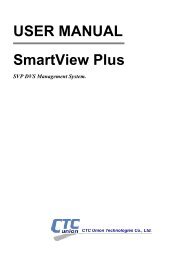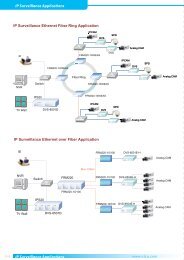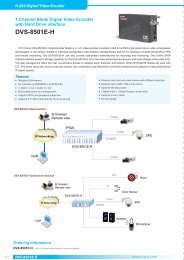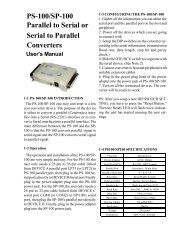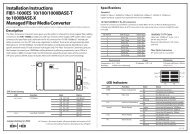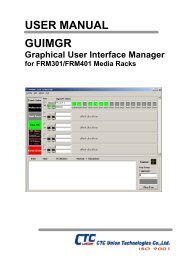EOe1-A User Manual - Products
EOe1-A User Manual - Products
EOe1-A User Manual - Products
Create successful ePaper yourself
Turn your PDF publications into a flip-book with our unique Google optimized e-Paper software.
Chapter 5. SNMP Operations<br />
5.1 Simple Network Management Protocol<br />
5.1.1 SNMP Overview<br />
30<br />
Chapter 5 SNMP Operations<br />
The Simple Network Management Protocol (SNMP) is one of many protocols in the Internet Protocol (IP) suite. SNMP<br />
is the protocol recommended specifically for the exchange of management information between hosts residing on IP<br />
networks. Network management allows you to monitor and control network devices remotely using conventional<br />
computer network technology.<br />
The SNMP management functions of the <strong>EOe1</strong>-A are provided by an internal SNMP agent, which utilizes in-band<br />
communication over standard 10/100BASE-TX Ethernet. The SNMP agent is compliant with the SNMPv1 standard.<br />
SNMP communication uses the <strong>User</strong> Datagram Protocol (UDP). UDP is a connectionless transport protocol, part of the<br />
IP suite. The SNMP protocol is an asynchronous command/response polling protocol and operates at the OSI Layer 7<br />
(Layer 7 is the Application Layer. Other examples of IP protocols that operate at this layer are FTP, Telnet, SMTP, etc.).<br />
All management traffic is initiated by the SNMP-based network management station. Only the addressed managed<br />
entity (agent) answers the polling of the management station (except for trap messages).<br />
All functions and settings accessible via the serial terminal connection or Web of the <strong>EOe1</strong>-A are also readable and<br />
settable via the Simple Network Management protocol.<br />
5.1.2 SNMP Operations<br />
The SNMP protocol includes four types of operations:<br />
getRequest Command for retrieving specific value of an "instance" from the managed node. The managed node<br />
responds with a getResponse message.<br />
getNextRequest Command for retrieving sequentially specific management information from the managed node. The<br />
managed node responds with a getResponse message.<br />
setRequest Command for manipulating the value of an "instance" within the managed node. The managed node<br />
responds with a getResponse message.<br />
trap Management message carrying unsolicited information on extraordinary events (that is, events which occurred not<br />
in response to a management operation) reported by the managed node.<br />
5.1.3 The Management Information Base<br />
The management information base (MIB) includes a collection of managed objects. Managed objects are defined as<br />
parameters that can be managed, such as specific information on device configuring or on performance statistics values.<br />
The MIB includes the definitions of relevant managed objects (MIB variables) for the specific node. Various MIB's can<br />
be defined for various management purposes, types of equipment, etc. The management data itself is a collection of<br />
integer, string and MIB address variables that contain all the information necessary to manage the node.<br />
A leaf object’s definition includes the range of instances (values) and the "access" rights:<br />
Read-only Instances of an object can be read, but cannot be set.<br />
Read-write Instances of an object can be read or set.<br />
Write-only Instances of an object can be set, but cannot be read.<br />
Not accessible Instances of an object cannot be read, nor set.



